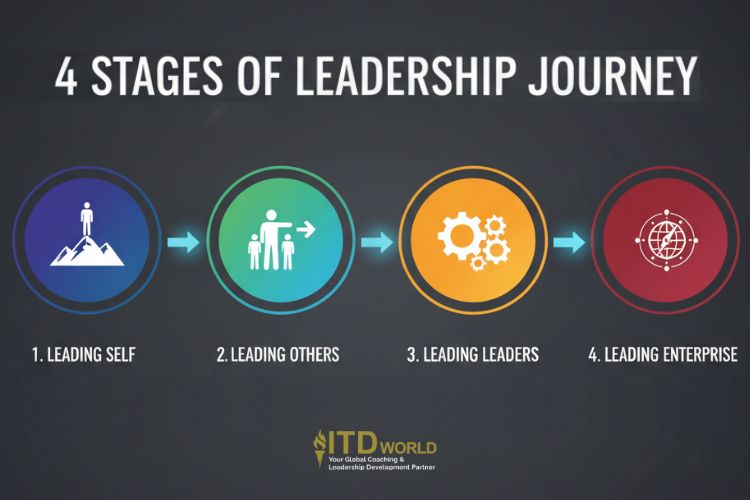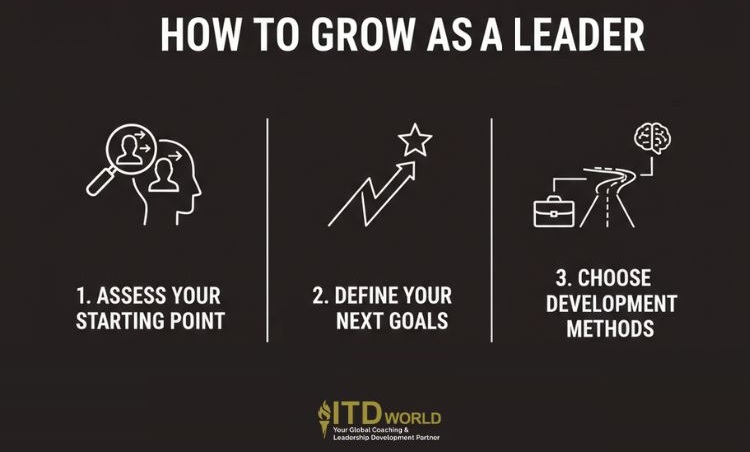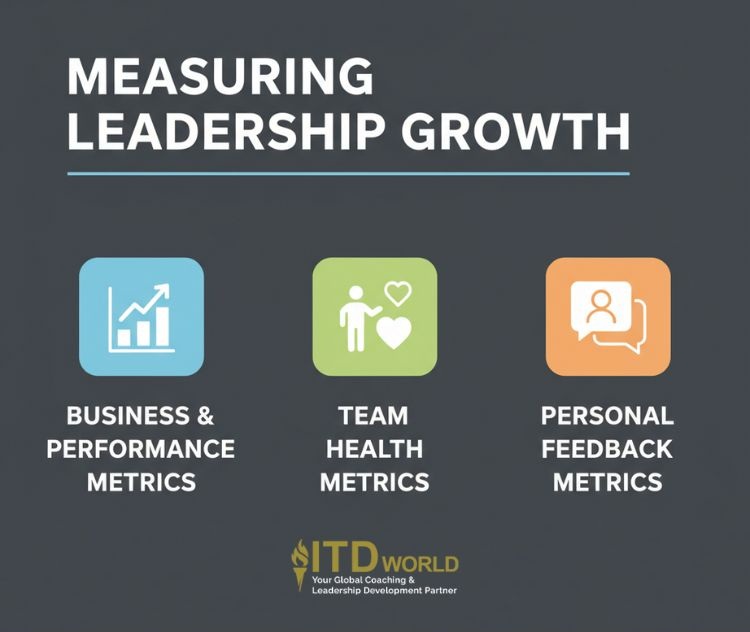Explore the 4 key stages of a leadership journey, plus actionable strategies to manage one’s growth at every phase of their career.
The most effective leaders are well aware of a fundamental truth: leadership is a journey, not a destination. A title or position on an organizational chart is merely a single milestone on a much longer path of continuous learning and adaptation. Understanding what it means to be on a leadership journey – how to grow as a leader at every stage – is key to fostering the resilience and commitment needed to navigate the challenges of the modern business world.
|
Author: Jonathan M. Pham |
Highlights
- The leadership journey is a continuous, evolving process of developing the self-awareness, competencies, and wisdom necessary to lead oneself, teams, and organizations effectively through ongoing challenges.
- Adopting a “journey” mindset is crucial for leaders – as it fosters growth, enables them to better navigate challenges, and drives continuous learning and adaptability essential for thriving in a rapidly changing business environment.
- The leadership journey is comprised of four distinct stages – Leading Self, Leading Others, Leading Leaders, and Leading the Enterprise – each demanding certain competencies and perspectives.
- To grow as a leader, one needs to proactively create a Leadership Growth Plan that involves self-assessment to pinpoint their current stage, define specific “next level” goals, and adopt a blend of development methods like formal training, coaching, and experiential learning.
- To measure leadership growth, consider implementing a balanced scorecard that tracks your impact through business and performance metrics, team health metrics, and personal feedback metrics.
- Common challenges on a leader’s development journey include plateaus of success that lead to stagnation, the “say-do” gap where actions contradict stated values, and major setbacks that can derail confidence.
What is the Leadership Journey?
The leadership journey is the lifelong process of developing the competencies, self-awareness, and wisdom needed to effectively lead yourself, your teams, and your organization through constantly evolving challenges. As mentioned, it is not a linear path with a fixed endpoint, but a continuous cycle of learning, applying newly acquired insights, reflecting on the outcomes, and adapting your approach.
Example: A leader might spend one phase of their journey mastering the technical skills of operational management to ensure their team delivers flawlessly. However, their next role might demand they unlearn some of those hands-on habits to master the art of strategic influence and developing other leaders. A “journey” mindset acknowledges that the skills that contribute to success at one stage must evolve for the next.
What got you here won’t get you there.
Why Leaders Need to Adopt a Journey Mindset
Adopting such a perspective is not just a philosophical preference; it is a strategic necessity that provides tangible advantages in today’s disruptive business environment.
- Fosters growth
The journey mindset is the practical application of what Stanford psychologist Carol Dweck calls a “growth mindset” – the belief that abilities are not fixed, but can be developed through dedication and hard work. Research has shown that leaders with a growth mindset foster teams that are more innovative, collaborative, and resilient – because they believe in their team’s capacity to learn and improve.
- Navigates challenges
When leaders view setbacks not as final failures but as temporary detours or learning opportunities on a longer path, they become far more adatapble. Various studies have revealed that a key quality of future leaders is their ability to reframe adversity – one that is inherent to the “journey” mindset – so that they may better absorb shocks and guide their teams forward with realistic optimism.
- Drives learning & adaptability
In a world where technology and market demands change at an unprecedented pace, a “destination” mindset – the assumption that one has “arrived” and mastered their craft – is disastrous. As highlighted in research by McKinsey, people who will thrive in the age of AI are those who embrace being lifelong learners. Knowing that there is no specific “end” to their path is what keeps leaders humble, curious, and open to the new knowledge required to stay relevant.

Leadership development journey
The Leadership Journey Map: Four Key Stages of Growth
While every leader’s journey is unique, their growth typically follow a predictable path through several distinct stages. Each phase presents new challenges and, therefore, demands a new set of competencies and a new perspective.
-
Leading self (the Foundation)
This is where every leadership journey begins, focusing on the individual before they are responsible for others.
- Primary focus: Mastering personal productivity, establishing a reputation for excellence and reliability, and building a foundational layer of self-awareness.
- The critical transition: The shift from being an excellent individual contributor to demonstrating the potential for leadership.
- Key development areas: At this stage, leaders must cultivate impeccable self-management, personal accountability, and the emotional intelligence (EQ) to understand their own strengths, weaknesses, and impact on others. In today’s world of remote work and digital distractions, the ability to lead oneself with discipline is the first critical test.
Read more: Emotional Intelligence in Leadership – How to Lead with Heart
-
Leading others (the People Leader)
The next stage is typically the most challenging transition, particularly for new managers and team leads.
- Primary focus: Achieving results through the work of other people for the first time.
- The critical transition: The difficult change from being the expert “doer” to becoming a “developer”/ “facilitator” of others.
- Key development areas: The essential competencies to be cultivated include effective delegation, giving constructive feedback, and basic coaching skills to motivate and guide a team. Given today’s hybrid work environment, leaders at this stage must also learn to master clear digital communication to keep dispersed teams aligned and engaged.
Read more: Human Leadership in a Digital World – Skills & Strategies for Sustainable Success
-
Leading leaders (the Multiplier)
The third stage applies to directors and senior managers who are now responsible for leading other managers.
- Primary focus: Moving from leading a single team to leading an entire function or department. Success is now measured by their ability to grow other leaders.
- The critical transition: The shift from tactical team management to more strategic, functional leadership.
- Key development areas: The required skills expand to include talent management & development, strategic thinking, and business acumen. Additionally, change management – the ability to guide their entire function through constant adaptation and organizational transformation – is also required to navigate the complexities of today’s VUCA world.
Read more: Leading Through Uncertainty – How to Stay Strong in Turbulent Times
-
Leading the enterprise (the Visionary)
This is the domain of senior and C-suite executives, where the scope of responsibility encompasses the entire organization.
- Primary focus: Setting the long-term vision, shaping the organizational culture, and managing complex stakeholder relationships.
- The critical transition: As one moves away from being in charge of a function to the whole enterprise, their perspective needs to change from internal operations to external market forces, long-term strategy, and legacy.
- Key development areas: Visionary leadership, enterprise-wide systems thinking, and sophisticated stakeholder management. Recently, a crucial growth area for leaders at this stage is navigating the strategic implications of AI and automation, not just as a technology, but as a force that will reshape their business model, industry, and workforce.

How to Grow as a Leader: Tips for Navigating the Journey
Great leaders are not passengers; they are active and intentional navigators of their own development. This requires taking ownership of one’s growth with a clear roadmap and consistent action.
A Leadership Growth Plan serves as your personal roadmap. It is a living document that translates your ambition to grow into a set of concrete, actionable strategies. Creating one typically involves three key steps as follows:
-
Pinpoint your location on the map through self-assessment
Before charting a course to your destination, you must first ensure an honest and accurate understanding of your starting point – by looking both inward for self-reflection and outward for objective data.
How-to: Start by reflecting on the “Leadership Journey Map” – which stage best describes your current role and primary challenges now? Then, validate this self-perception with external input. This is where tools like 360-degree feedback, formal performance reviews, and candid conversations with your manager or a trusted coach/ mentor are invaluable for identifying your strengths and hidden blind spots.
Read more: Soliciting Feedback – Key to a Building a Better Workplace
-
Define your “next level” goals
The next step is to define the target for the next phase of your journey – by pinpointing the 1-3 most critical skills or mindsets needed to succeed at the current stage and prepare for the next. As a rule of thumb, your goals should be forward-looking and stage-appropriate.
Example:
- A leader at Stage 2 (Leading Others) might set an objective like: “Master the skill of delegating outcomes, not just tasks, to empower my team and free up 20% of my time for more strategic work over the next six months.”
- One preparing for Stage 4 (Leading the Enterprise) might come up with one like: “Develop my financial acumen by completing a ‘finance for non-financial leaders’ course and shadowing our CFO during the next quarterly review process.”
-
Choose your development methods
With a well-defined list of goals, the final step of the plan is to select the right “vehicles” for the journey. It is recommended that you adopt a blended approach, combining a variety of learning methods.
How-to: Your plan should include a mix of the following:
- Formal leadership training: Look for specific workshops or certificate programs that directly target your development goals.
- Coaching & mentoring: Proactively seek out a mentor who has already mastered the competencies you need, or partner with a professional coach to accelerate your growth and ensure accountability.
- Experiential learning: This is where the most powerful learning happens. Actively volunteer for “stretch” assignments – projects that will force you to practice and refine your target skills in a real-world, high-stakes environment.
Read more: Leadership Values – 10 Qualities for Exceptional Results

How to grow as a leader in the organization
How to Measure Leadership Growth
A growth plan without measurement is just a set of good intentions. To stay motivated, demonstrate progress, and refine your strategy over time, it is essential to track your growth. One way to do this is by utilizing a “balanced scorecard” of metrics that provides a holistic view of your leadership journey, looking at your impact on the business, your team, and yourself.
- Business & performance metrics (the “What”)
This is about tracking the tangible results of your leadership. As your capabilities grow, the performance of your team and function should, obviously, improve.
How to measure: Track the Key Performance Indicators (KPIs) most relevant to your role (make sure to define them in your growth plan).
Example: If the target was to improve team innovation, you could track something like “the number of new product features shipped per quarter.” On the other hand, if your focus was on operational excellence, you might look at “a reduction in project delivery times.” An upward trend in these metrics is a reliable sign of your growing effectiveness.
- Team health metrics (the “How”)
Great leaders achieve outstanding results without burning out their teams. These metrics measure the health, morale, and stability of the team you lead, which is a direct reflection of your leadership environment.
How to measure: Pay close attention to your team’s employee engagement survey scores and voluntary turnover rate.
Example: If you spent six months working on your coaching and feedback skills, you should expect to see a corresponding improvement in your team’s engagement scores, particularly in the survey questions related to “opportunities for growth” and “feeling valued.”
- Personal feedback metrics (the “You”)
This is about measuring the direct perception of your leadership behaviors from those you work with most closely – i.e. how your personal growth is being experienced by others.
How to measure: One of the best tools for this is the 360-degree feedback assessment. By comparing your scores in key competencies from one year to the next, you can get quantifiable data on your improvement. In addition, try gathering qualitative data by asking your manager or a trusted mentor for direct input: “Last year, you noted that I needed to improve my strategic communication. Based on our recent leadership meetings, what progress have you seen, and where do I still need to improve?”

Common Challenges on One’s Leadership Journey
Like any meaningful journey, the path of leadership development is not a straight line. It is filled with inevitable roadblocks, challenging detours, and unexpected plateaus.
- The plateau of success
This is one of the most subtle but common derailers. A leader achieves a high level of competence and success in their current role, becomes comfortable, and their learning and development begin to stagnate. They stop feeling challenged, and their growth stalls.
Solution: Proactively seek discomfort. Specifically, a leader must be the agent of their own growth. When you feel you have mastered your current role, it is a signal that it is time to seek a new challenge that will force you to learn and adapt.
Example: One could volunteer for a “stretch assignment,” such as taking on a project in an unfamiliar area of the business. Additionally, seeking out a mentor who is already at the “next level” can provide the fresh perspective needed to figure out new growth opportunities and avoid complacency.
- The “say-do” gap
A leader has a well-defined leadership philosophy on paper but, under the pressure of daily work, their actions begin to contradict their stated values. For example, one who values “empowerment” finds themselves micromanaging a high-stakes project. This gap erodes their authenticity and their team’s trust.
Solution: Practice disciplined self-reflection and seek accountability. Closing the above-mentioned gap requires the self-awareness to see it and the discipline to correct it.
In practice: One may keep a journal to reflect on their actions at the end of each week, asking, “Where did my actions align with my philosophy, and where did they diverge?” The next step is to find an accountability partner – a coach, mentor, or trusted peer – and give them permission to call out the gap respectfully when they see it.
Read more: Leading by Example – Key to Truly Inspiring Action & Trust
- Navigating a major setback
A significant project failure, a missed team target, or a personal career setback can completely shake one’s confidence and derail their journey. For many, the natural temptation is to become defensive, assign blame, or withdraw.
Solution: Reframe one’s mindset. This is the ultimate test of a “journey mindset.” Resilient leaders understand that setbacks are not endpoints, but data points for future growth.
Example: Think about the journey of Nelson Mandela. What could have been seen as the ultimate failure – 27 years of unjust imprisonment – became a period of profound reflection that forged his incredible resilience and wisdom. He demonstrated that even the most severe misfortunes can be reframed as a transformative stage of a leader’s journey, preparing them for the challenges that lie ahead.
Read more: 7 Leadership Mistakes to Avoid – From Failure to Success

Leadership journey examples
Leadership Journey Quotes
Check out more leadership quotes here!
The very essence of leadership is that you have to have a vision. You can’t blow an uncertain trumpet.
Theodore M. Hesburgh
Before you are a leader, success is all about growing yourself. When you become a leader, success is all about growing others.
Jack Welch
The function of leadership is to produce more leaders, not more followers.
Ralph Nader
A leader is one who knows the way, goes the way, and shows the way.
Do not follow where the path may lead. Go instead where there is no path and leave a trail.
Ralph Waldo Emerson
Leadership Journey Books
- 📘 The Leadership Journey: How Four Kids Became President by Doris Kearns Goodwin
A compelling middle-grade biography that traces the early lives of Abraham Lincoln, Theodore Roosevelt, Franklin D. Roosevelt, and Lyndon B. Johnson. Goodwin highlights how each overcame unique childhood challenges to become transformative U.S. presidents. It’s an inspiring look at how character and resilience shape leaders from a young age.
- 📗 Leadership: In Turbulent Times by Doris Kearns Goodwin
This adult-focused companion dives deeper into the leadership styles of the same four presidents. Goodwin examines how adversity shaped their decision-making and moral courage.
- 📙 The Leadership Journey: How to Master the Four Critical Areas of Being a Great Leader by Gary Burnison
Burnison, CEO of Korn Ferry, outlines a practical framework for leadership growth. The book focuses on four key areas: self-awareness (“Look in the Mirror”), purpose, collaboration, and vision. It’s concise, actionable, and ideal for professionals seeking to elevate their professional impact.
- 📕 The Journey of Leadership: How CEOs Learn to Lead From the Inside Out by Dana Maor, Hans-Werner Kaas, Kurt Strovink & Ramesh Srinivasan
Based on interviews with 24+ CEOs, this McKinsey-backed book explores how top leaders evolve through self-reflection, humility, and bold decision-making. It’s a rich blend of storytelling and strategy for those navigating executive leadership.

Let’s Skyrocket Your Leadership Journey with ITD World
At ITD World, we specialize in providing world-class development solutions that support leaders at every stage of their journey. Our programs are designed to provide the specific skills, mindsets, and perspectives needed to master your current stage and prepare effectively for the next.
- For new & emerging leaders: ITD World’s suite of solutions for newly appointed managers and high-potential individuals provide the foundational competencies in delegation, effective communication, and team management needed to successfully make the critical transition from “doing” to “leading others.”
- For senior and executive leaders: Our Senior Leadership Development Program (SLDP) is designed for those who need to master the complexities of leading other leaders and driving enterprise-wide strategy. We focus on imparting the strategic thinking, change management, and visionary capabilities required at the highest levels.
- For everyone: To support continuous growth at any stage, we offer one-on-one executive coaching and mentoring programs. These provide a personalized, confidential partnership to help you acquire deeper self-awareness, tackle the most pressing challenges, and accelerate your growth.
Ready to intentionally take control of your leadership journey? Contact ITD World today to discover the right solution to support you on the path!
Other resources you might be interested in:
- Leadership Branding: Crafting an Inspiring Personal Identity
- 12 Golden Leadership Principles for Attaining Excellence
- 12 Leadership Coaching Topics to Drive Lasting Results

